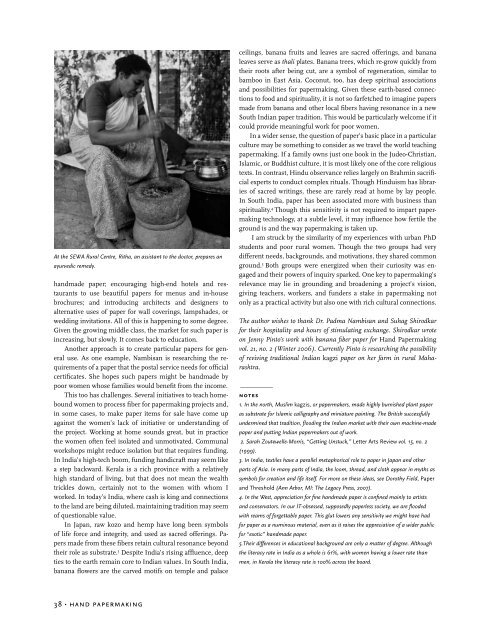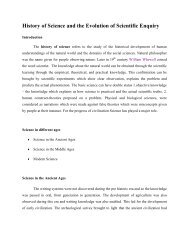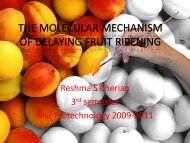Papermaking Where There is No Papermaking Tradition - (CUSAT ...
Papermaking Where There is No Papermaking Tradition - (CUSAT ...
Papermaking Where There is No Papermaking Tradition - (CUSAT ...
Create successful ePaper yourself
Turn your PDF publications into a flip-book with our unique Google optimized e-Paper software.
At the SEWA Rural Centre, Ritha, an ass<strong>is</strong>tant to the doctor, prepares an<br />
ayurvedic remedy.<br />
handmade paper; encouraging high-end hotels and restaurants<br />
to use beautiful papers for menus and in-house<br />
brochures; and introducing architects and designers to<br />
alternative uses of paper for wall coverings, lampshades, or<br />
wedding invitations. All of th<strong>is</strong> <strong>is</strong> happening to some degree.<br />
Given the growing middle class, the market for such paper <strong>is</strong><br />
increasing, but slowly. It comes back to education.<br />
Another approach <strong>is</strong> to create particular papers for general<br />
use. As one example, Namb<strong>is</strong>an <strong>is</strong> researching the requirements<br />
of a paper that the postal service needs for official<br />
certificates. She hopes such papers might be handmade by<br />
poor women whose families would benefit from the income.<br />
Th<strong>is</strong> too has challenges. Several initiatives to teach homebound<br />
women to process fiber for papermaking projects and,<br />
in some cases, to make paper items for sale have come up<br />
against the women’s lack of initiative or understanding of<br />
the project. Working at home sounds great, but in practice<br />
the women often feel <strong>is</strong>olated and unmotivated. Communal<br />
workshops might reduce <strong>is</strong>olation but that requires funding.<br />
In India’s high-tech boom, funding handicraft may seem like<br />
a step backward. Kerala <strong>is</strong> a rich province with a relatively<br />
high standard of living, but that does not mean the wealth<br />
trickles down, certainly not to the women with whom I<br />
worked. In today’s India, where cash <strong>is</strong> king and connections<br />
to the land are being diluted, maintaining tradition may seem<br />
of questionable value.<br />
In Japan, raw kozo and hemp have long been symbols<br />
of life force and integrity, and used as sacred offerings. Papers<br />
made from these fibers retain cultural resonance beyond<br />
their role as substrate. 3 Despite India’s r<strong>is</strong>ing affluence, deep<br />
ties to the earth remain core to Indian values. In South India,<br />
banana flowers are the carved motifs on temple and palace<br />
ceilings, banana fruits and leaves are sacred offerings, and banana<br />
leaves serve as thali plates. Banana trees, which re-grow quickly from<br />
their roots after being cut, are a symbol of regeneration, similar to<br />
bamboo in East Asia. Coconut, too, has deep spiritual associations<br />
and possibilities for papermaking. Given these earth-based connections<br />
to food and spirituality, it <strong>is</strong> not so farfetched to imagine papers<br />
made from banana and other local fibers having resonance in a new<br />
South Indian paper tradition. Th<strong>is</strong> would be particularly welcome if it<br />
could provide meaningful work for poor women.<br />
In a wider sense, the question of paper’s basic place in a particular<br />
culture may be something to consider as we travel the world teaching<br />
papermaking. If a family owns just one book in the Judeo-Chr<strong>is</strong>tian,<br />
Islamic, or Buddh<strong>is</strong>t culture, it <strong>is</strong> most likely one of the core religious<br />
texts. In contrast, Hindu observance relies largely on Brahmin sacrificial<br />
experts to conduct complex rituals. Though Hindu<strong>is</strong>m has libraries<br />
of sacred writings, these are rarely read at home by lay people.<br />
In South India, paper has been associated more with business than<br />
spirituality. 4 Though th<strong>is</strong> sensitivity <strong>is</strong> not required to impart papermaking<br />
technology, at a subtle level, it may influence how fertile the<br />
ground <strong>is</strong> and the way papermaking <strong>is</strong> taken up.<br />
I am struck by the similarity of my experiences with urban PhD<br />
students and poor rural women. Though the two groups had very<br />
different needs, backgrounds, and motivations, they shared common<br />
ground. 5 Both groups were energized when their curiosity was engaged<br />
and their powers of inquiry sparked. One key to papermaking’s<br />
relevance may lie in grounding and broadening a project’s v<strong>is</strong>ion,<br />
giving teachers, workers, and funders a stake in papermaking not<br />
only as a practical activity but also one with rich cultural connections.<br />
The author w<strong>is</strong>hes to thank Dr. Padma Namb<strong>is</strong>an and Suhag Shirodkar<br />
for their hospitality and hours of stimulating exchange. Shirodkar wrote<br />
on Jenny Pinto’s work with banana fiber paper for Hand <strong>Papermaking</strong><br />
vol. 21, no. 2 (Winter 2006). Currently Pinto <strong>is</strong> researching the possibility<br />
of reviving traditional Indian kagzi paper on her farm in rural Maharashtra.<br />
___________<br />
notes<br />
1. In the north, Muslim kagz<strong>is</strong>, or papermakers, made highly burn<strong>is</strong>hed plant paper<br />
as substrate for Islamic calligraphy and miniature painting. The Brit<strong>is</strong>h successfully<br />
undermined that tradition, flooding the Indian market with their own machine-made<br />
paper and putting Indian papermakers out of work.<br />
2. Sarah Zoutewelle-Morr<strong>is</strong>, “Getting Unstuck,” Letter Arts Review vol. 15, no. 2<br />
(1999).<br />
3. In India, textiles have a parallel metaphorical role to paper in Japan and other<br />
parts of Asia. In many parts of India, the loom, thread, and cloth appear in myths as<br />
symbols for creation and life itself. For more on these ideas, see Dorothy Field, Paper<br />
and Threshold (Ann Arbor, MI: The Legacy Press, 2007).<br />
4. In the West, appreciation for fine handmade paper <strong>is</strong> confined mainly to art<strong>is</strong>ts<br />
and conservators. In our IT-obsessed, supposedly paperless society, we are flooded<br />
with reams of forgettable paper. Th<strong>is</strong> glut lowers any sensitivity we might have had<br />
for paper as a numinous material, even as it ra<strong>is</strong>es the appreciation of a wider public<br />
for “exotic” handmade paper.<br />
5.Their differences in educational background are only a matter of degree. Although<br />
the literacy rate in India as a whole <strong>is</strong> 61%, with women having a lower rate than<br />
men, in Kerala the literacy rate <strong>is</strong> 100% across the board.<br />
38 • hand papermaking














